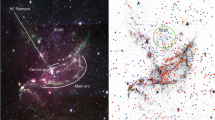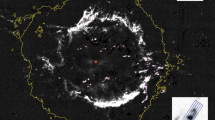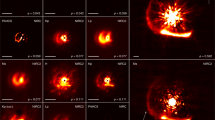Abstract
Massive colliding-wind binaries that host a Wolf–Rayet (WR) star present a potentially important source of dust and chemical enrichment in the interstellar medium. However, the chemical composition and survival of dust formed from such systems is not well understood. The carbon-rich Wolf–Rayet binary WR 140 presents an ideal astrophysical laboratory for investigating these questions, given its well-defined orbital period and predictable dust-formation episodes every 7.93 years around periastron passage. We present observations from our Early Release Science programme (ERS 1349) with the James Webb Space Telescope Mid-Infrared Instrument (MIRI) Medium-Resolution Spectrometer and Imager that reveal the spectral and spatial signatures of nested circumstellar dust shells around WR 140. MIRI medium-resolution spectroscopy of the second dust shell and Imager detections of over 17 shells formed throughout approximately the past 130 years confirm the survival of carbonaceous dust grains from WR 140 that are probably carriers of ‘unidentified infrared’-band features at 6.4 and 7.7 μm. The observations indicate that dust-forming carbon-rich Wolf–Rayet binaries can enrich the interstellar medium with organic compounds and carbonaceous dust.
This is a preview of subscription content, access via your institution
Access options
Access Nature and 54 other Nature Portfolio journals
Get Nature+, our best-value online-access subscription
$29.99 / 30 days
cancel any time
Subscribe to this journal
Receive 12 digital issues and online access to articles
$119.00 per year
only $9.92 per issue
Buy this article
- Purchase on Springer Link
- Instant access to full article PDF
Prices may be subject to local taxes which are calculated during checkout





Similar content being viewed by others
Data availability
Data used in this study were obtained under JWST Director’s Discretionary Early Release Science programme ID ERS 1349 and have no exclusive access period. Data can be obtained from the Mikulski Archive for Space Telescopes (MAST; https://archive.stsci.edu/missions-and-data/jwst).
References
Marchenko, S. V. & Moffat, A. F. J. Search for polycyclic aromatic hydrocarbons in the outflows from dust-producing Wolf-Rayet stars. Mon. Not. R. Astron. Soc. 468, 2416–2428 (2017).
Lau, R. M. et al. Revisiting the impact of dust production from carbon-rich Wolf-Rayet binaries. Astrophys. J. 898, 74 (2020).
Endo, I. et al. Detection of a Broad 8 μm UIR feature in the mid-infrared spectrum of WR 125 observed with Subaru/COMICS. Astrophys. J. 930, 116 (2022).
Crowther, P. A. Physical properties of Wolf-Rayet stars. Annu. Rev. Astron. Astrophys. 45, 177–219 (2007).
Usov, V. V. Stellar wind collision and dust formation in long-period, heavily interacting Wolf-Rayet binaries. Mon. Not. R. Astron. Soc. 252, 49–52 (1991).
Williams, P. M. et al. Orbitally modulated dust formation by the WC7+O5 colliding-wind binary WR140. Mon. Not. R. Astron. Soc. 395, 1749–1767 (2009).
Eatson, J. W., Pittard, J. M. & Van Loo, S. Exploring dust growth in the episodic WCd system WR140. Preprint at https://arxiv.org/abs/2204.12354 (2022).
Tuthill, P. G., Monnier, J. D. & Danchi, W. C. A dusty pinwheel nebula around the massive star WR104. Nature 398, 487–489 (1999).
Cherchneff, I., Le Teuff, Y. H., Williams, P. M. & Tielens, A. G. G. M. Dust formation in carbon-rich Wolf-Rayet stars. I. Chemistry of small carbon clusters and silicon species. Astron. Astrophys. 357, 572–580 (2000).
Monnier, J. D. et al. First visual orbit for the prototypical colliding-wind Binary WR 140. Astrophys. J. Lett. 742, L1 (2011).
Fahed, R. et al. Spectroscopy of the archetype colliding-wind binary WR 140 during the 2009 January periastron passage. Mon. Not. R. Astron. Soc. 418, 2–13 (2011).
Thomas, J. D. et al. The orbit and stellar masses of the archetype colliding-wind binary WR 140. Mon. Not. R. Astron. Soc. 504, 5221–5230 (2021).
Rate, G. & Crowther, P. A. Unlocking galactic Wolf-Rayet stars with Gaia DR2 - I. Distances and absolute magnitudes. Mon. Not. R. Astron. Soc. 493, 1512–1529 (2020).
Bouchet, P. et al. The Mid-Infrared Instrument for the James Webb Space Telescope, III: MIRIM, the MIRI Imager. Publ. Astron. Soc. Pac. 127, 612 (2015).
Wright, G. S. et al. The Mid-Infrared Instrument for the James Webb Space Telescope, II: design and build. Publ. Astron. Soc. Pac. 127, 595 (2015).
Wells, M. et al. The Mid-Infrared Instrument for the James Webb Space Telescope, VI: the Medium Resolution Spectrometer. Publ. Astron. Soc. Pac. 127, 646 (2015).
Lau, R. M. et al. Resolving decades of periodic spirals from the Wolf-Rayet dust factory WR 112. Astrophys. J. 900, 190 (2020).
Han, Y. et al. The extreme colliding-wind system Apep: resolved imagery of the central binary and dust plume in the infrared. Mon. Not. R. Astron. Soc. 498, 5604–5619 (2020).
Han, Y., Tuthill, P. G., Lau, R. M. & Soulain, A. Radiation driven acceleration in the expanding WR140 dust shell. Nature (2022); https://doi.org/10.1038/s41586-022-05155-5
Perrin, M. D. et al. Updated point spread function simulations for JWST with WebbPSF. In Space Telescopes and Instrumentation 2014: Optical, Infrared, and Millimeter Wave SPIE Conference Series Vol. 9143 (eds Oschmann, J. et al.) 91433X (SPIE, 2014).
Williams, P. M. & Eenens, P. R. J. Displaced He I absorption lines in Wolf-Rayet stars : revisions to v-infinite. Mon. Not. R. Astron. Soc. 240, 445–457 (1989).
Arnal, E. M. A high-resolution H I study of the interstellar medium local to HD 193793. Astron. J. 121, 413–425 (2001).
Lau, R. M. et al. Revealing efficient dust formation at low metallicity in extragalactic carbon-rich Wolf-Rayet binaries. Astrophys. J. 909, 113 (2021).
Peeters, E. et al. The rich 6 to 9 μm spectrum of interstellar PAHs. Astron. Astrophys. 390, 1089–1113 (2002).
Leger, A. & Puget, J. L. Identification of the unidentified infrared emission features of interstellar dust. Astron. Astrophys. 137, L5–L8 (1984).
Allamandola, L. J., Tielens, A. G. G. M. & Barker, J. R. Polycyclic aromatic hydrocarbons and the unidentified infrared emission bands: auto exhaust along the milky way. Astrophys. J. Lett. 290, L25–L28 (1985).
Tielens, A. G. G. M. Interstellar polycyclic aromatic hydrocarbon molecules. Annu. Rev. Astron. Astrophys. 46, 289–337 (2008).
Allamandola, L. J., Tielens, A. G. G. M. & Barker, J. R. Interstellar polycyclic aromatic hydrocarbons: the infrared emission bands, the excitation/emission mechanism, and the astrophysical implications. Astrophys. J. Suppl. Ser. 71, 733 (1989).
Chiar, J. E., Peeters, E. & Tielens, A. G. G. M. The infrared emission features in the spectrum of the Wolf-Rayet star WR 48a. Astrophys. J. Lett. 579, L91–L94 (2002).
Helton, L. A., Evans, A., Woodward, C. E. & Gehrz, R. D. Atypical dust species in the ejecta of classical novae. In EAS Publications Series Vol. 46, PAHs and the Universe: A Symposium to Celebrate the 25th Anniversary of the PAH Hypothesis (eds Joblin, C. & Tielens, A. G. G. M.) 407–412 (EAS, 2011).
García-Hernández, D. A., Rao, N. K. & Lambert, D. L. Dust around R Coronae Borealis stars. II. Infrared emission features in an H-poor environment. Astrophys. J. 773, 107 (2013).
Harrington, J. P., Lame, N. J., Borkowski, K. J., Bregman, J. D. & Tsvetanov, Z. I. Discovery of a 6.4 micron dust feature in hydrogen-poor planetary nebulae. Astrophys. J. Lett. 501, L123–L126 (1998).
Li, A. Spitzer’s perspective of polycyclic aromatic hydrocarbons in galaxies. Nat. Astron. 4, 339–351 (2020).
Galliano, F., Dwek, E. & Chanial, P. Stellar evolutionary effects on the abundances of polycyclic aromatic hydrocarbons and supernova-condensed dust in galaxies. Astrophys. J. 672, 214–243 (2008).
Eldridge, J. J. et al. Binary Population and Spectral Synthesis version 2.1: construction, observational verification, and new results. Publ. Astron. Soc. Aust. 34, e058 (2017).
Lindegren, L. et al. Gaia Early Data Release 3. The astrometric solution. Astron. Astrophys. 649, A2 (2021).
Labiano, A. et al. Wavelength calibration and resolving power of the JWST MIRI Medium Resolution Spectrometer. Astron. Astrophys. 656, A57 (2021).
Earl, N. et al. astropy/specutils: V1.7.0. Zenodo (2022); https://doi.org/10.5281/zenodo.6207491
Gordon, K. D. et al. Milky Way mid-infrared Spitzer spectroscopic extinction curves: continuum and silicate features. Astrophys. J. 916, 33 (2021).
Callingham, J. R. et al. Anisotropic winds in a Wolf-Rayet binary identify a potential gamma-ray burst progenitor. Nat. Astron. 3, 82–87 (2019).
Marchenko, S. V. et al. The unusual 2001 periastron passage in the "clockwork” colliding-wind binary WR 140. Astrophys. J. 596, 1295–1304 (2003).
Astropy Collaboration. The Astropy Project: building an open-science project and status of the v2.0 core package. Astron. J. 156, 123 (2018).
Lim, P. L. et al. spacetelescope/jdaviz: v2.8.0. Zenodo (2022); https://doi.org/10.5281/zenodo.6877878
Acknowledgements
R.M.L. thanks the members of the entire WR DustERS team for their valuable discussions and contributions to this work. We thank A. Moro-Martin, W. Januszewki, N. Reid, M. Meixner and B. Meinke for their support in the planning and execution of our ERS programme. We would also like to acknowledge the MIRI instrument and MIRISim teams for their insightful feedback and support of our observation and data analysis plans. We are grateful to K. Gordon for his guidance on the MIRI Imager data reduction. The work of R.M.L. is supported by NOIRLab, which is managed by the Association of Universities for Research in Astronomy (AURA) under a cooperative agreement with the National Science Foundation. Y.H. acknowledges funding from the Gates Cambridge Trust. M.F.C. and K.H. were supported by NASA under award number 80GSFC21M0002. O.C.J. acknowledges support from an STFC Webb fellowship. A.F.J.M. is grateful for financial aid from NSERC (Canada). J.S.-B. acknowledges support from the Mexican Council of Science (CONACyT) "Ciencia de Frontera" project CF-2019/263975. C.M.P.R. acknowledges support from NATA ATP grant number 80NSSC22K0628 and NASA Chandra Theory grant number TM2-23003X. This work is based on observations made with the NASA/ESA/CSA James Webb Space Telescope. The data were obtained from the Mikulski Archive for Space Telescopes at the Space Telescope Science Institute, which is operated by the Association of Universities for Research in Astronomy, Inc., under NASA contract number NAS 5-03127 for JWST. These observations are associated with programme ERS 1349. Support for programme ERS 1349 was provided by NASA through a grant from the Space Telescope Science Institute, which is operated by the Association of Universities for Research in Astronomy, Inc., under NASA contract number NAS 5-03127.
Author information
Authors and Affiliations
Contributions
R.M.L. led the analysis and is PI of the WR DustERS Team. R.M.L. and M.J.H. conceived and designed the project. I.A. and D.R.L. processed the MRS data, and M.G.M. processed the MIRI imaging data. Y.H. and P.T. constructed the geometric models of WR 140. All authors contributed to observation planning and/or scientific interpretation as members of the WR DustERS Team.
Corresponding author
Ethics declarations
Competing interests
The authors declare no competing interests.
Peer review
Peer review information
Nature Astronomy thanks Paul Crowther, Joseph Callingham and the other, anonymous, reviewer(s) for their contribution to the peer review of this work.
Additional information
Publisher’s note Springer Nature remains neutral with regard to jurisdictional claims in published maps and institutional affiliations.
Rights and permissions
Springer Nature or its licensor holds exclusive rights to this article under a publishing agreement with the author(s) or other rightsholder(s); author self-archiving of the accepted manuscript version of this article is solely governed by the terms of such publishing agreement and applicable law.
About this article
Cite this article
Lau, R.M., Hankins, M.J., Han, Y. et al. Nested dust shells around the Wolf–Rayet binary WR 140 observed with JWST. Nat Astron 6, 1308–1316 (2022). https://doi.org/10.1038/s41550-022-01812-x
Received:
Accepted:
Published:
Issue Date:
DOI: https://doi.org/10.1038/s41550-022-01812-x
This article is cited by
-
Carbon-chain chemistry in the interstellar medium
Astrophysics and Space Science (2024)
-
A 12.4-day periodicity in a close binary system after a supernova
Nature (2024)
-
Carbonaceous dust grains seen in the first billion years of cosmic time
Nature (2023)



